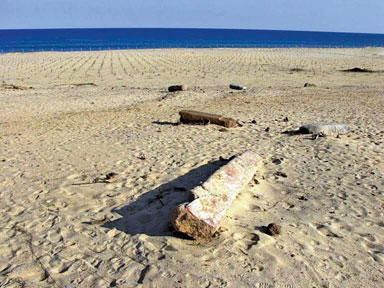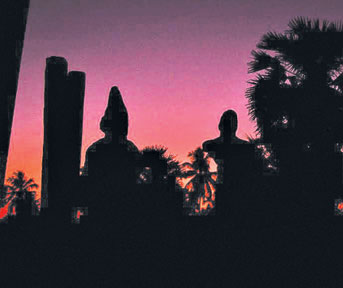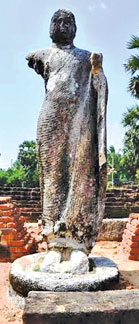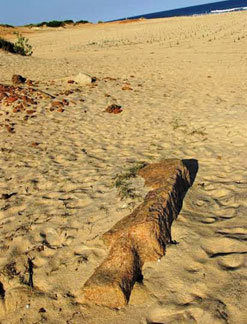 |
|
The main Buddha statue,
two figures and whole structure |
 |
|
Buried stone pillars on
the sea shore |
 |
|
The statues at sunset
over Muhudu Maha Vihare |
Buried glory in the East coast
By Mahil Wijesinghe
Having passed lush greenery along Wellawaya to Lahugala on the A4
Road a strange landscape accosts you when passing Sengamuwa. About 10 km
beyond Pottuvil, on the A4 Road, a stretch of barren paddy field dotted
with small houses and herds of white goats and cows lazily grazing could
be seen. Most villagers ply the road on push bicycles, a popular and
cost-effective mode of transport. Here fishing and farming is the main
form of livelihood.
|

Main Buddha statue at Muhudu Maha Vihare |
Entering the crowded Pottuvil town, populated by Muslims, it reminds
one of the swarming dens of Colombo’s slum dwellers. However, the haven
of windsurfers, the world famous Arugam Bay, lies on the eastern
boundary of Pottuvil. The white sand dunes stood out like immaculate
rocks scattered along the sandy coast. For thousands of years these
mighty dunes have protected the land from progressive sea encroachment.
Beneath the white sand lies buried, the glorious story of our heritage.
Ruins
The historic Muhudu Maha Vihare in Arugam Bay, in Pottuvil is the
only Buddhist religious site on this eastern seashore. The ruins of the
site could be seen juxtaposed among the sand dunes.
The shade of a mango tree gave us shelter before meeting with the
temple’s chief Bhikku. The breeze across the Bay of Arugam rejuvenated
us and gave a short respite from the tiring and hectic eight-hour
journey from Ratnapura.
East of Pottuvil, there lies a historical site called Muhudu Maha
Vihare, once a venerated Buddhist place of worship in the East. Its
dagoba now lies there, buried amidst the ruins. To its west are the
remains of a pillared structure where the torso of a Buddha statue was
found and later renovated by the Department of Archaeology.
The sea shore covers much of the site where the dagoba lies, not yet
excavated. Several stone pillars and broken bricks are visible from
nearby. When this was uncovered, there emerged two beautiful life-size
stone statues of Bodhisattva Avalokitesvara. This is now believed to be
perhaps an ancient foundation which was later overlaid by Mahayanism.
|

The statue believed to be of Queen Vihara Maha Devi |
Today, the Muhudu Maha Vihare faces the grave problem of losing its
archaeological value. The main reason being the lack of a Sinhala
population in the area pilgrims from all over the island once frequented
this locale and donated money to build these Buddhist sites.
Hardship
Several Bhikkus continue to live in the temple premises despite
severe hardship to preserve and protect the site from further decay and
ruin.
During the war on terrorism in the East, these Bhikkus hardly
received alms even for basic needs. The security forces who were
assigned to give security to the temple shared their meagre meals with
the Bhikkus. The situation has changed today as more and more pilgrims
and visitors throng the site each day and bestow many donations to
uplift the area.
The survey plan of the temple shows that the Muhudu Maha Vihare
possessed 264 acres of land on the coastal strip. A government gazette
notification issued in 1965 states that the temple had been given 30
acres of land and is protected as an archaeological reserve.
Unfortunately, the temple now has only three acres as the rest of the
land has been acquired by villagers.
 History relating to the Muhudu Maha Vihare dated back to the reign of
King Mahanaga, who built this temple in 552 B.C. Legend has it that the
country suffered a terrible tsunami during the reign of King Kavantissa. History relating to the Muhudu Maha Vihare dated back to the reign of
King Mahanaga, who built this temple in 552 B.C. Legend has it that the
country suffered a terrible tsunami during the reign of King Kavantissa.
The king scarified his only daughter to the sea to avert a catastrophe.
The king’s daughter was later washed ashore near the East coast, where
Muhudu Maha Vihare stands today.
Later King Kavantissa who ruled Ruhuna,
had met Vihara Maha Devi on this same shore, and to commemorate this
historical event, the Vihare was built on the coast of the Arugam Bay
site. Just 10 km away from Muhudu Maha Vihare in Pottuvil into the land
in Lahugala, there lies another temple called Magul Maha Vihare with a
number of ruins including a stone carved wedding platform (Magul Poruwa)
believed to be used by King Kavantissa and Queen Vihara Maha Devi who it
is said were married at this site.
The sand dunes absorb the merciless sun rays during the scorching
midday heat, and attempting to tread on the dunes is akin to walking on
red hot embers.
|

Ruins unearthed from the sand |
The rest of the stone pillars and bricks buried beneath could also be
seen. The best time to visit this site is early morning or late
afternoon. If you are in the site at dawn, you can probably see the
magnificent sunrise over the Arugam Bay.
Buddha statue
It is believed that there are many ruins buried beneath the shore.
Presently, the torso of the Buddha statue and two stone-carved figures
are believed to be Avalokitesvara figures or King Kavantissa and Queen
Vihara Maha Devi and are easily visible. All these statues were restored
by the Department of Archaeology several years ago. Before restoration
the statues were scattered along the ground exposed to the elements,
vandals and treasure hunters.
Muhudu Maha Vihare is ample historical evidence of a Buddhist
population that once inhabited the land close to Pottuvil in centuries
past and made the route to Anuradhpura from Magam via Pottuvil a popular
one.
|

